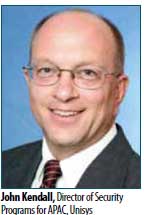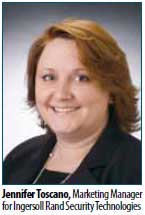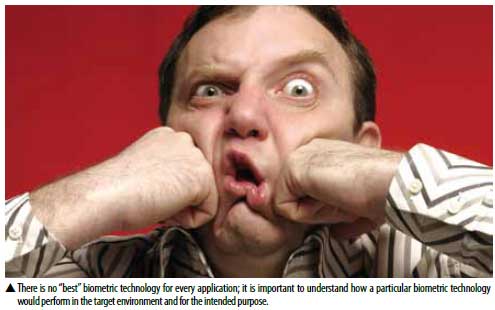The worldwide market for biometric identification (not limited to physical access control) grew to US$2.6 billion in 2009, and research from Acuity indicates that revenues will reach $10.9 billion by 2017. Other studies show higher projections, pegging the worldwide market at $5 billion in 2010, growing to $12 billion by 2015 at a CAGR of 18.9 percent. In this two-part feature, a&s explores the latest advances and applications in biometrics and RFID authentication, addresses real-life usage and development issues, and outlines where the technologies might be headed.
The worldwide market for biometric identification (not limited to physical access control) grew to US$2.6 billion in 2009, and research from Acuity indicates that revenues will reach $10.9 billion by 2017. Other studies show higher projections, pegging the worldwide market at $5 billion in 2010, growing to $12 billion by 2015 at a CAGR of 18.9 percent. In this two-part feature, a&s explores the latest advances and applications in biometrics and RFID authentication, addresses real-life usage and development issues, and outlines where the technologies might be headed. 
Today, the general public is more aware of the changing security landscape, not just from high-profile terrorist threats, but also from malicious threats such as ID theft and financial fraud, said John Kendall, Director of Security Programs for APAC, Unisys. “Because of this, people are more open to forego some level of private information in return for greater security where they see there is likely to be a benefit to them.”
 Growth has been hindered mostly by a lack of education. “Biometric technology is surrounded by many myths and misnomers; therefore, to gain 100-percent acceptance, the biometric community must educate,” said Scott Mahnken, VP of Marketing, Bio-Key International. “We are devoting a substantial part of the 2012 budget to educating the marketplace at all levels, including consumers, who are concerned about the cost of modifying existing infrastructure along with some old- school thinking.”
Growth has been hindered mostly by a lack of education. “Biometric technology is surrounded by many myths and misnomers; therefore, to gain 100-percent acceptance, the biometric community must educate,” said Scott Mahnken, VP of Marketing, Bio-Key International. “We are devoting a substantial part of the 2012 budget to educating the marketplace at all levels, including consumers, who are concerned about the cost of modifying existing infrastructure along with some old- school thinking.”
Market Potential
 There are two main drivers for biometrics — accuracy and user-friendliness. Accuracy can be broken down into two additional categories — security concerns and reporting accuracy. If access control systems are to control where people, not credentials, can and cannot go, then only a biometric device truly provides this capability. “That's why more and more biometric readers are showing up in access control systems where there are needs for high security,” said Jennifer Toscano, Marketing Manager for Ingersoll Rand Security Technologies.
There are two main drivers for biometrics — accuracy and user-friendliness. Accuracy can be broken down into two additional categories — security concerns and reporting accuracy. If access control systems are to control where people, not credentials, can and cannot go, then only a biometric device truly provides this capability. “That's why more and more biometric readers are showing up in access control systems where there are needs for high security,” said Jennifer Toscano, Marketing Manager for Ingersoll Rand Security Technologies.
“In addition, biometrics are user-friendly. While keys don't cost much and dramatic price reductions have lowered the capital cost of cards in recent years, the true benefit of eliminating them is realized through reduced administrative efforts. For instance, a lost card or key must be replaced and reissued by someone, just as there's a price associated with the time spent to complete this seemingly simple task. When added together, the overall administration of a key or card system is costly. Hands are not lost, stolen or forgotten. They also don't wear out or need to be replaced.”
Plus, biometrics are easy to administer, install and maintain. “Replacing card readers with biometric ones in many cases is simply an unplug-plug-and-play operation. It's also easy to control threshold levels, tightening access control in a nuclear power plant while loosening the level at a spa. This allows the facility to provide the appropriate balance of security and convenience for its application and end users,” Toscano continued.
 Although there has been some recovery on a global scale in 2011, markets may only reach the 2008 revenue levels most probably next year,said Hans -Gernot Illig, CEO of SimonsVoss Technologies . “We estimated that in 2010, the global market for access control readers was approximately US$ 650 to 700 million. RFID-enabled access control readers accounted for an estimated 25 percent of that revenue, and biometric solutions should still be less than 20 percent of the market. However, it should be noted that the largest market still comprises out of other technologies, like proprietary active transponders. It is our observation that worldwide market segments, such as governmental, commercial and institutional, focus on a wide variety of technologies like secure active transponder and RFID technologies. In Asia, however, the market has an increased interest in biometric technologies.”
Although there has been some recovery on a global scale in 2011, markets may only reach the 2008 revenue levels most probably next year,said Hans -Gernot Illig, CEO of SimonsVoss Technologies . “We estimated that in 2010, the global market for access control readers was approximately US$ 650 to 700 million. RFID-enabled access control readers accounted for an estimated 25 percent of that revenue, and biometric solutions should still be less than 20 percent of the market. However, it should be noted that the largest market still comprises out of other technologies, like proprietary active transponders. It is our observation that worldwide market segments, such as governmental, commercial and institutional, focus on a wide variety of technologies like secure active transponder and RFID technologies. In Asia, however, the market has an increased interest in biometric technologies.”
 In Frost & Sullivan's APAC biometrics market analysis, related hardware revenues surpassed $165 million in 2009, and the regional market is estimated to reach $700.7 million in 2015.
In Frost & Sullivan's APAC biometrics market analysis, related hardware revenues surpassed $165 million in 2009, and the regional market is estimated to reach $700.7 million in 2015.
The US government procurement process is “dysfunctional,” and the larger agencies in charge of making sure standards are completed and enforcements are done are dormant, criticized Brian Skiba, President of MaxID. “So US government spending is not a reliable source of business for anyone who is not a government contractor behemoth. Growth is coming from the private sector, driven by concerns on cost containment and risk mitigation, and from the rest of the world where governments are deploying identity solutions at a much more interesting pace.”